Hey there, groovy Tor.commers! I’ll have you know this Movie Rewatch of Great Nostalgia is really happening in a far out way!
Today’s entry for the Movie Rewatch of Great Nostalgia is 1981’s Clash of the Titans. There are Titans! They clash! You should come see what we thought of it!
Previous entries can be found here. Please note that as with all films covered on the Nostalgia Rewatch, this post will be rife with spoilers for the film.
And now, the post!
LIZ: We need to get out of this 80s rut.
KATE: For real.
Though I pointed out that as people whose childhoods took place almost entirely in the 80s, it’s not exactly surprising that the majority of our childhood nostalgia movies were made in that decade… well, probably, yeah.
KATE: Let’s do an older movie! The 70s, baby!
LIZ: Yeah. Something with wacky effects and groovy disco vibe!
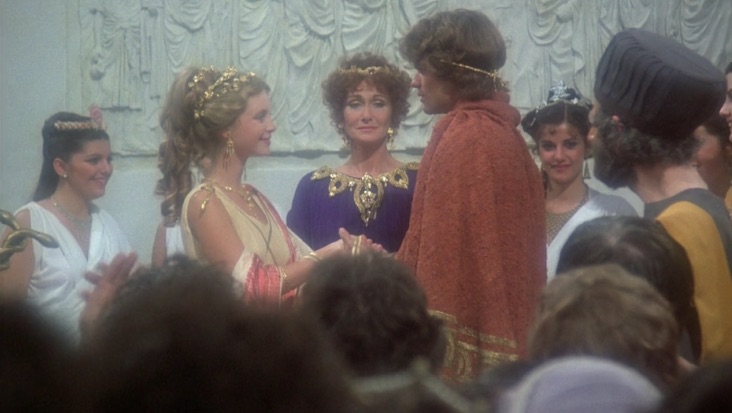
…Yeah, so, we are geniuses. Because we thusly leaped upon the idea of doing Clash of the Titans, and it wasn’t until movie night itself that we realized that our groovy 70s movie had actually been made in… 1981.
Oops?
KATE: Eh, whatever. 1981 is honorary “the 70s”, anyway.
She’s not wrong, really. The 80s kind of took a while to shake off the “Me” decade, at least in some respects. Certainly when it came to hair.
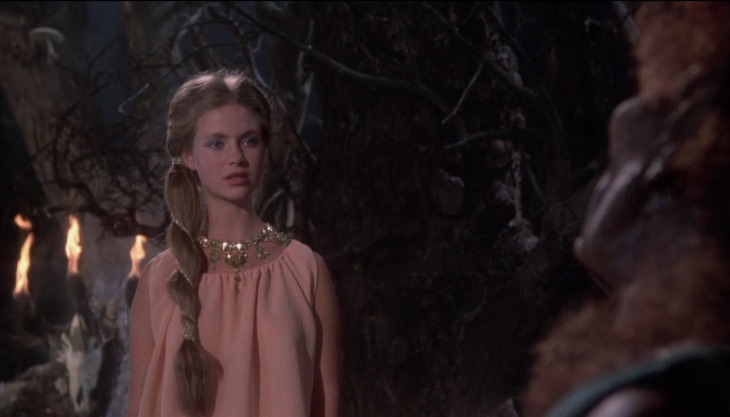
I totally want to try to make my hair do that, y’all.
Anyway! The original Clash of the Titans (I have not seen the 2010 remake, nor do I have any particular plans to do so) is that most bizarre of phenomenons: a throwback within a throwback. By which I mean, it’s already a throwback in that I am watching a film made in 1981 in 2017, but it was also a throwback of sorts even in its own time.
The guy in that clip is, of course, none other than Ray Harryhausen, the special effects artist famous for his pioneering work in stop-motion animation effects throughout the 50s, 60s, and 70s. Clash of the Titans is the last feature film he did the effects for, though he worked on a number of smaller projects before his death in 2013.
Harryhausen is neither the first nor the last major figure in creature effects, or even in stop-motion animation effects in particular, but he is regarded with near worshipful reverence by practically everyone in the field. Among his ardent fans are filmmakers like Steven Spielberg, James Cameron, Peter Jackson, and Tim Burton, all of whom have credited Harryhausen’s work as inspiring their own. The folks at Pixar paid homage to his contribution to the animation field by naming the sushi restaurant in Monsters, Inc. after him. George Lucas has said that there wouldn’t have been a Star Wars without Harryhausen.
But the funny thing (to me, anyway) is, the special effects of Star Wars may have been inspired by Harryhausen, but they unquestionably were also far more sophisticated and realistic than the claymation techniques Harryhausen was known for. Which is what makes Clash of the Titans so odd, because it was made four years after Star Wars, and yet looks primitive enough by comparison that my sisters and I immediately assumed it must have been made at least ten years earlier than it actually had been. Yes, shame on us for not checking right away, but seriously, look at this movie and tell us we were off base, there.

So really, it seems like what Clash of the Titans was, was a love letter to Ray Harryhausen more than anything else. Which is great… if that happens to be your thing.
It does not, in fact, happen to be my thing.
KATE: Not mine either, really.
LIZ: GASP!
Liz was, as I’m sure many of you out there are as well, appalled by Kate’s and my lack of enthusiasm for the work of the patron saint of monster effects. And maybe we are appalling. But I feel like I can appreciate the historical significance and the retro charm of stop-motion claymation animation effects, while still vastly preferring the advances in technology that allow those effects to truly be seamless and believable. A lot of purists mourn the advent of CGI in movie effects, but personally, while I certainly agree CGI can be used badly, I am of the opinion that computer generated special effects are the best thing that ever happened to science fiction and fantasy fans.
[ETA: As I am informed by the comments, Harryhausen’s techniques are stop-motion animation, not claymation. I stand corrected!]

Liz disagrees, somewhat. She likes CGI too, but unlike me, she has a background in traditional animation techniques, and is therefore in a much better position to be appreciative of the detail and labor that goes into stop-motion animation than either Kate or I am. She also argued that the jerky primitiveness of the animation in Clash of the Titans was on purpose. I am a little skeptical of this claim, because it seems to me that there is a hard upper limit on how smooth you can get any stop-motion movement, especially when juxtaposed with actual human movement in the same frame, but admittedly this is not my arena, so maybe I should hush up. But indeed, judge for yourselves:
That said, it’s worth pointing out that despite what I wrote above, I still have no desire to go watch the 2010 remake of this movie, even though it is guaranteed to have the vastly superior CGI effects I just professed to prefer. Eh, sometimes nostalgia trumps even aesthetics. And consistency is the hobgoblin of small minds, so there!
Also, there’s Bubo!

One thing I know for sure is that I loved Bubo the mechanical owl when I saw this as a kid. When this movie was brought up as a possibility for the MRGN, Bubo was instantly the first thing I thought of.
ME: I want a Bubo!
KATE: I dunno, he’s kind of the poor man’s R2D2.
Liz then accused Kate of being a Debbie Downer, but she has a point, really. I loved Bubo as a kid, but, well, Lucas really did do “bumbling robotic comic relief” much better at least as long as you don’t count the prequels but there are no prequels what on earth are you talking about.
That said, if I had lots of money to spend on stupid things I would totally want a Bubo replica to perch in my living room.
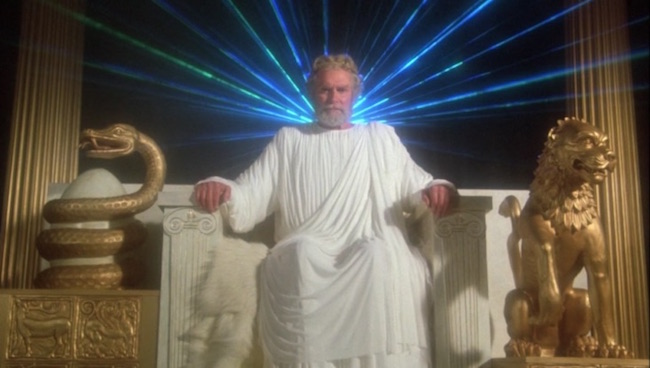
KATE: Also, Zeus is a dick.
LIZ: A dick with LASERS.
ME: Well, that’s mythologically consistent, at least.
LIZ & KATE: …
ME: The dick thing, not the laser thing. Sheesh.
Seriously. While the actual storyline of the film played quite fast and loose with the particulars of the myth it was based on, they certainly captured the spirit of the Greek gods, who as a group can probably be most efficiently summed up as “Celestial Mean Girls”. They are all, in one way or another, selfish, vain, capricious and/or cruel, and Clash of the Titans nailed that aspect of them even if it made something of a random hash of how Perseus’s story played out.
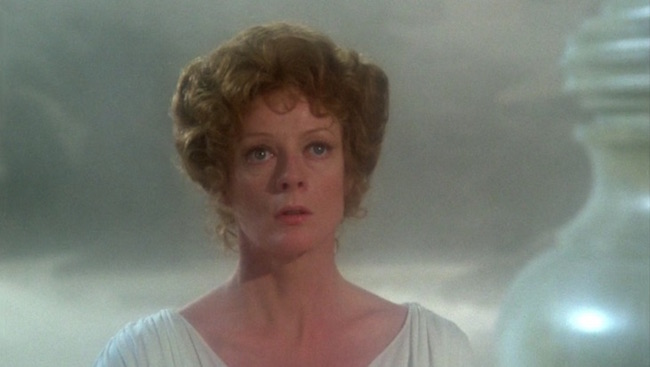
It also, incidentally, provided us with Maggie Smith and Laurence Olivier getting to be magnificently bitchy at each other in togas, which is not something you get to see every day. Plus additional fun in the form of Ursula Andress having like two lines as Aphrodite.
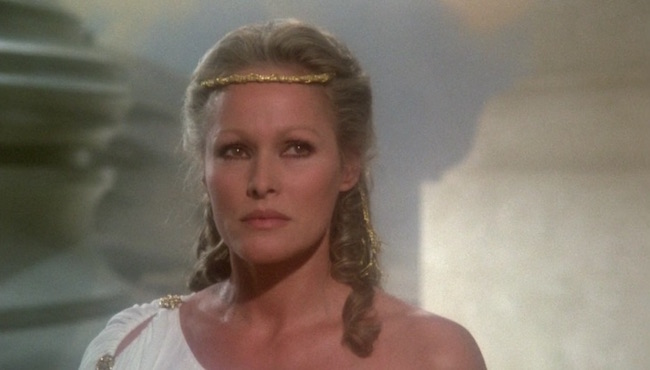
Aphrodite: “But Zeus transformed himself into a glittering shower of gold and visited her. Visited her, and loved her.”
Uh-huh. You’d think the Goddess of Love would know the difference between “love” and “rape”, wouldn’t you, but hey!
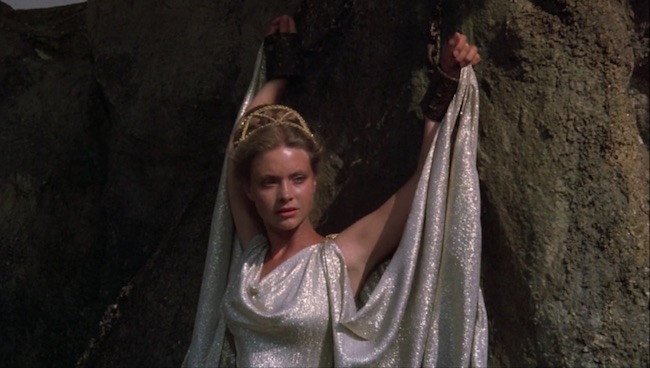
KATE: SO. DISCO.
ME: Did they have silver lamé in ancient Greece?
LIZ: I wouldn’t call that lamé. It’s more like a glitter mesh.
ME: Okay, did they have glitter mesh fabric in ancient Greece?
KATE: We’re just lucky she’s not naked.
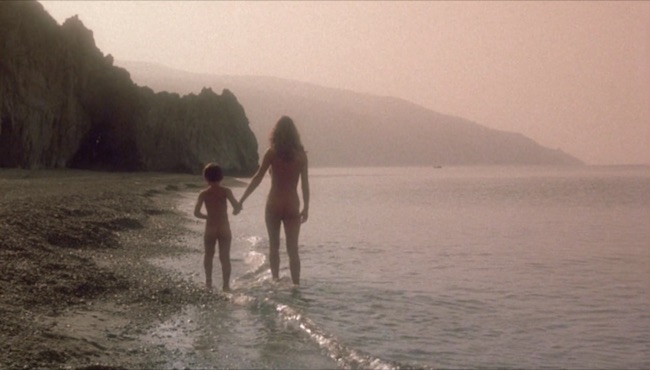
Although, there was a bit more nekkidness than I remember in this movie. But we only ever saw it on TV, which would have been edited for content, so that’s undoubtedly why.
But back to Andromeda! The amount of sexism in this movie was probably more or less inevitable, considering the source, so I tried not to let it get to me too much. It helped that even though Andromeda is literally the textbook definition of a damsel in distress—she’s a virgin sacrifice chained to a rock, ffs—the film depicts her as being strong-willed, independent, and generally deeply unimpressed with the various people who victimize her throughout the film. She still doesn’t ultimately have much agency over her life, but at least she has an actual personality. I’ll take what I can get.
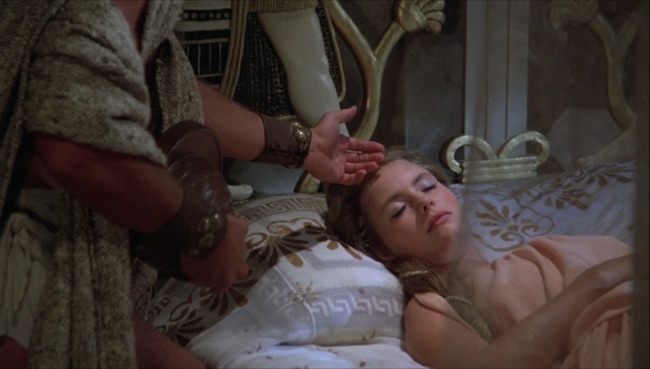
Sigh.
And then there’s the hero of the piece, Perseus himself, portrayed by Harry Hamlin’s loins.
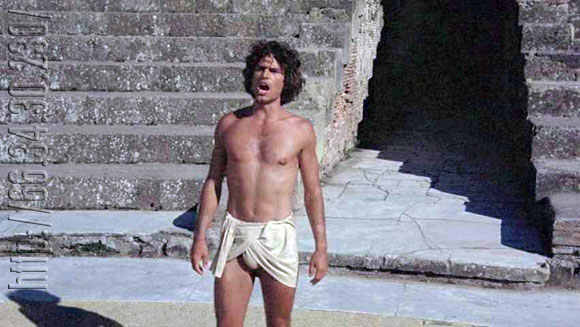
And hair.
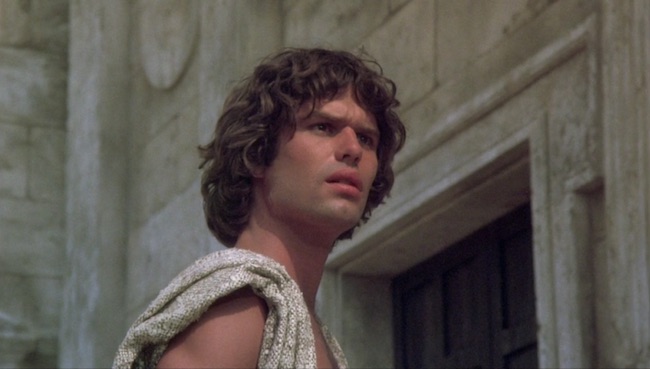
KATE: Man, does he look dumb.
LIZ: Kate!
KATE: Well, he does! I keep wondering where his cave is!
Again, she’s… not wrong. It’s the brow, I think. I dunno, I remember that Harry Hamlin was a fairly big star in the early 80s, and presumably there were people who thought he was attractive, but I can state with authority that I wasn’t one then, and am definitely not one of them now. Even if he does have objectively lovely loins.
In any case, I don’t know that I can say Hamlin did a good acting job in this movie, because he… kind of didn’t. But honestly that might have been because he really didn’t have much to work with, because almost everyone in the cast came across just as wooden and stiff. Except Maggie Smith, who is awesome no matter what she’s doing. And except Laurence Olivier, who was far too busy Oliviering all over everything to be beaten down by mere shoddy material.
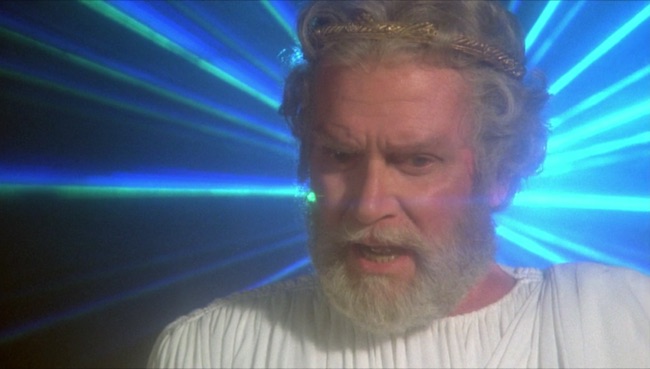
LIZ: Plus, LASERS.
Zeus: RELEASE THE KRAKEN!!
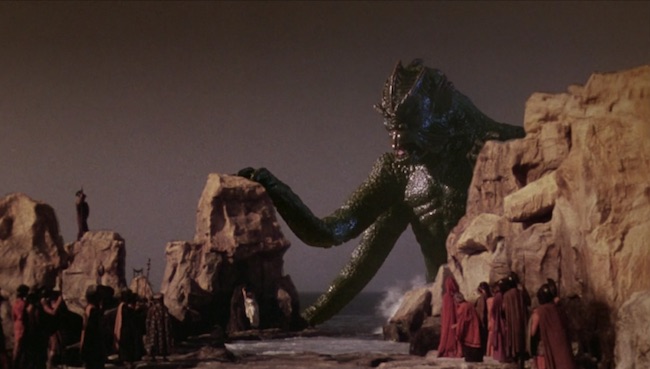
ME: Oh, yeah, that’s where that came from.
LIZ & KATE: “Put that thing back where it came from or so help me…”
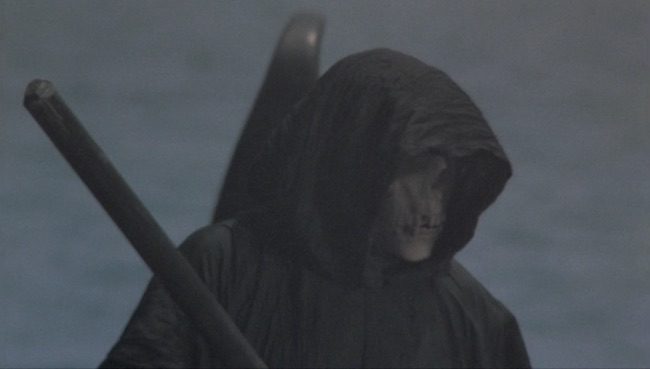
LIZ: Now the ferryman, I remember. He was so creepy and cool.
ME: See, the effects are so much better when they’re not claymation!
LIZ: Ugh.
Yeah, well. I’m aware that I’m veering around kind of wildly in this post, critically speaking, but what can you do? I have a lot of very fond memories of watching Clash of the Titans as a kid, but I have to say that watching it again now rather soured those memories more than anything else. My nostalgia, in this case, was really just not enough to overcome the—sorry—distractingly primitive special effects, the stilted acting, and worst of all, the absolutely glacial pace, which quite efficiently strangled any sense of suspense or excitement I might otherwise have generated.
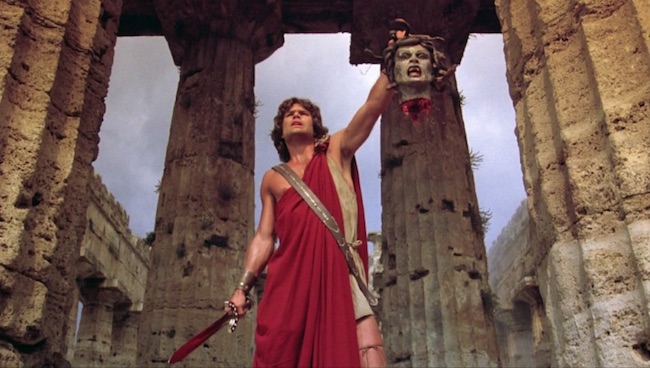
Yeah, this shot? Took almost a minute to happen. I mean, come on.
There were moments of brilliance, and some unquestionably iconic imagery, and it’s not impossible that watching this movie was what sparked my early interest in Greek mythology (which I was very into as a kid), but overall I think that unless you are a diehard Ray Harryhausen devotee (or a diehard Harry Hamlin devotee, I suppose, though I feel like there are fewer of those), Clash of the Titans is going to be something of a letdown.
For the record, Liz disagrees with me, mostly. And with Kate, whose opinion of the film is even lower than mine. Which is why, for the first time, we’re going to have to split up the Nostalgia Love to Reality Love 1-10 Scale of Awesomeness by sister, because we really could not agree on a single score.
LIZ:
- Nostalgia: 8
- Reality: 6
KATE:
- Nostalgia: 6
- Reality: 3
LEIGH:
- Nostalgia: 7
- Reality: 4
And that’s all I got for you on this one, my dears! Come on back Thursday after next, and see if we actually manage to achieve escape velocity from the Reagan years! Whoo!










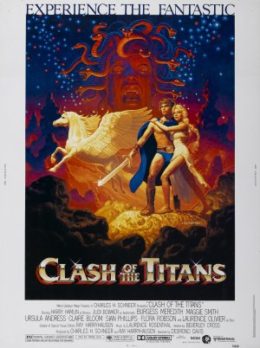
The animation notwithstanding, I appreciate this version much more than the remake. The only good scene was Perseus vs. Medusa, which then leads to some giant scorpion attacks (in the remake, really giant ones), before they deal with the kraken. My nostalgia for Bubo was apparently more nostalgic than I remember, as he really didn’t hold up. Still, I agree with your rankings Leigh.
Somehow, the remake got a sequel in Wrath of the Titans. Huh, maybe I’ll catch that one on Netflix sometime…
Gumby was “claymation.” This is not. It’s stop-motion.
Thanks
I like the scene where Zeus transforms Calibos into the satyr. I also liked when, as revenge, Thetis takes the minature form of Perseus and places him in the amphitheatre. The next scene we see Harry Hamlin’s Perseus wake up in the amphitheatre.
Thanks for reading my musings.
AndrewHB
Harryhausen did not use “Claymation.” That began as a brand name for the plasticine-clay stop-motion animation employed by Will Vinton’s studio, and has come to be used generically for other plasticine-based animation such as the Gumby films. Ray Harryhausen’s figures were made of foam rubber and poseable metal armatures, not clay. His technique was often referred to as “Dynamation,” though this was strictly a marketing term.
The stop-motion techniques used by Phil Tippett in the Star Wars films were essentially the exact same ones used by Harryhausen — and I don’t think there really was any stop motion in the original film except for the dejarik (holo-chess) game on the Falcon. As for the tauntaun and AT-AT sequences in Empire, the one major difference from Harryhausen’s work is that they used motion control to allow a moving camera vantage, and occasionally used motorized, motion-control camera and model moves to introduce motion blur in the stop-motion frames — a forerunner of the “go-motion” technique that ILM would embrace fully starting with Dragonslayer. The lack of motion blur was sort of a trademark of Harryhausen’s work. A contemporary stop-motion animator, Jim Danforth, liked to use multiple exposures of consecutive frames, overlapping the poses to create the appearance of motion blur, and his work looked impressively smooth as a result. (He had a low opinion of go-motion, feeling that all the required motors and bluescreens restricted the animators’ freedom too much.) But for whatever reason, Harryhausen was content to stick with his more pointillist approach, prioritizing the performance and personality of his stop-motion characters over the fluidity of their motion.
Worth noting, though, that Clash is the first film that Harryhausen didn’t do solo. He was assisted by Danforth and Steve Archer. So it’s not exactly pure Harryhausen.
As it happens, though, Clash was my introduction to Harryhausen’s work. If I’d seen any of his earlier movies on TV, I hadn’t been aware of his involvement in them. It was the movie that got me interested in his work in the first place — although at first, I knew it better from the novelization than from actually seeing the film itself. But there was a time in high school where one of our teachers showed it to the class (I’m not sure which class), the first time I ever saw it uncut. The nude scenes came as a pleasant surprise…
And, yes, Bubo was very much intended to remind people of R2-D2.
Another Harryhausen film to consider for rewatch (or watch for the first time): “The Valley of Gwangi,” or as I like to call it Cowboys & Dinosaurs! Truly amazing no one has remade it—not that I want a remake. It’s my favorite of his movies. Okay, sure, it’s pretty much a King Kong ripoff set in Mexico…
Did I mention it has cowboys and dinosaurs?
I was 18 or 19 when this came out, and I loathed it deeply. Largely because the effects were disappointing after John Dykstra had revolutionized the field, but also because the script and the acting were so bad. Bubo was another huge problem, since I was familiar with his precursors Muffitt and Twiki, who had taken “cute robot companion” in entirely the wrong direction in the very few years since R2-D2. Of course, R2 himself may owe something to Huey, Dewey and Louie from Silent Running (which could be your answer for a 70s film, with Logan’s Run being another option). And Harry Hamlin may have made a decent lawyer in the late 80s, but he was horribly miscast as an epic hero.
So now I’m trying to think good 70’s movies that have the requisite nostalgia content. Airplane and Caddyshack come to mind, but it’s hard to call those nostalgic when I rewatch one or the other (or both) every year. (I’ve worn out my DVD copy of Caddyshack. Seriously.) Stripes was 1980 (I got to see it on my 10th birthday, so it’s easy to remember) so that doesn’t count. How about Meatballs, the first of the Bill Murray and Ivan Reitman collaborations? Or going with one more like Clash of the Titans, how about Krull? That might just be nostalgic for me since it’s the first drive-in movie I saw, and at that age I didn’t care how awful it was.
@7/Nick31: Krull was from 1983.
Don’t waste your time on the 2010 version or the sequel. No Maggie Smith. She’s just the best.
Just curious, was there already nostalgia for Harryhausen’s animation style in 1981? Seems a little early to be an intentional throwback, but with the advent of other special effects techniques around that time I suppose it’s not out of the realm of possibility. Did the filmmakers comment on this?
My rating for this one is much higher (and, needless to say, completely unrelated to the nekkidness). I don’t think it’s Harryhausen’s best film (that’d be Golden Voyage of Sinbad or maybe Jason & the Argonauts, depending on when you ask), but I think it’s his best animation work. I don’t know if it’s so much that it was an intentional throwback as that the borders between different special effects eras are fuzzy especially given how long something like this probably would’ve spent in preproduction.
And the “remake” was … unnecessary. Ditto the sequel. And from that era when Sam Worthington was in everything for no discernable reason.
I feel like you should watch the remake just to see if it fares better than the original. Don’t get me wrong, its not a good movie, but it has Liam Neeson as Zeus, so that’s something.
I have much more fondness and nostalgia for this one than Leigh does. I’m probably a tad bit older, so I have a certain fondness for Harryhausen’s stop motion monsters from having watched much of his earlier work as a kid; such fun classics like Jason and the Argonauts and a bunch of Sinbad movies.
SINBAD….
He was a bad dude
Well, if you like Harry Hamlin you can always watch him in Veronica Mars :) There’s actually a secne where he’s watching Clash of the Titans before…some spoilery thing happens :)
As far as getting out of the 1980s, how about the original Muppet Movie (1979)? Or some of the truly awful Godzilla movies (Megalon, Gigan) of the era? Or is that just my great nostalgia?
@10/Arthur: I wouldn’t say it was nostalgia, per se — rather, it was a style that had been around for a long time and hadn’t yet come to be seen as obsolete. Yes, Star Wars and ILM revolutionized film effects, but that didn’t happen overnight. It’s not like every movie after May 1977 was suddenly made with Star Wars-level effects. It was more of a gradual transition. Heck, ILM itself disbanded after SW and didn’t reform until The Empire Strikes Back. (Its staffers went on to work on various other productions, including Battlestar Galactica and Filmation’s Space Academy.) And Harryhausen and his style of animation still had plenty of fans, plenty of cachet with SF/fantasy film audiences.
And as I said, it isn’t really accurate to call Harryhausen’s methods a throwback for the time. Other stop-motion animators like Phil Tippett used essentially the same techniques, aside from improvements in camera movement and motion control, up until Jurassic Park changed the game in 1993. (And the CGI effects in JP were actually done using stop-motion techniques — except that, instead of animating and photographing lifelike models, Tippett’s crew animated bare armatures with sensors that entered their joint movements into computers as the controls for the digital models.) If there’s a difference, it may lie in the fact that Harryhausen’s films relied primarily on stop-motion, while ILM used more of a mix of techniques — for instance, Bubo might’ve been more convincing as a cable-controlled puppet or something in close-ups. The advanting of mixing up different FX techniques is that it makes any single technique less obvious, and lets you use the best method for any given shot. (Although Clash had some of that, using a made-up actor for Calibos in close-ups and an animated miniature in long-shots.)
@2 and @@.-@:
Duly noted, and acknowledged in the post!
Also, sorry for the messed-up video clips, guys. Should all be fixed now!
#16
I meant throwback by the use of stop-motion in organic creatures, where it’s, arguably, “less convincing” than the jerky movements of machines like the AT-AT. There seemed to be a move away at that time from stop-motion to other techniques in that respect. See the rod puppet ghosts in Raiders of the Lost Ark or the rancor in Return of the Jedi a couple years later. Had that been done ten or twenty years earlier it most likely would’ve been stop-motion.
I look at the above picture of the kraken, and that says ’50s or ’60s nostalgia to me. Not that there’s anything wrong with that. I love Harryhausen’s work too.
@19/Arthur: Plenty of organic creatures in later movies were animated by stop-motion or go-motion: the tauntauns in Empire, the dragon in Dragonslayer, Indiana Jones and friends in the mine car sequence in Temple of Doom, the 2-headed dragon Eborsisk and its victims in Willow, the Terror Dogs in Ghostbusters, the Deadites in the Evil Dead movies, etc. As I said, the dinosaurs in Jurassic Park were going to be stop-motion in long shots until the computer graphics folks convinced Spielberg that they could pull it off. So it was absolutely not a throwback technique in 1981. Certainly it had its limitations that filmmakers were unhappy with; John Carpenter cut a stop-motion sequence out of The Thing because he found it unconvincing, and Spielberg planned JP to keep the use of stop-motion to a minimum because it was less convincing than the animatronic dinosaurs (which is why, contrary to popular belief, the vast majority of the dinosaur shots in JP are live-action animatronics rather than CG). And of course, ILM developed go-motion as a way to compensate for the limits of stop-motion. But it was a technique that remained in steady use, for both organic and mechanical entities, until CGI supplanted it in the ’90s.
Besides, how can anyone say Clash is old-fashioned? It has lasers! And nudity! ;)
Sigh. I loooooooved this movie as a kid. Guess I won’t watch it again.
The remake was… enh. Not good, not unwatchable.
https://www.youtube.com/watch?v=mUbf2f5aDoE
If I possessed the necessary skills (and if it wasn’t already 7 years too late), I’d go into the trailer for the Clash of the Titans remake and overlay it with God of War-style button prompts.
I grew up watching this, and my nostalgia is so strong it still holds up on repeat viewings! I was born in 1985, so there were already more advanced effects by the time I was paying attention to movies, but it didn’t matter. I was aaaalll over Titans, Argonauts, Sinbad… Just obsessed with mythology in general and loving the stop motion.
I still disagree with the idea that Harryhausen’s effects were less advanced than contemporary stuff — they were just more specialized, doing one thing very well instead of using a wider mix of techniques. Other stop-motion animators used essentially the same techniques throughout the ’80s, sometimes with other refinements added like go-motion, but sometimes not. Possibly the last great stop-motion action set piece in live-action feature films before CGI supplanted it (or at least one of the last) was the climactic battle in 1990’s RoboCop 2, done by Phil Tippett, and I’d say the techniques used there were mostly pretty much identical to Harryhausen’s.
And of course, stop-motion animation isn’t dead; it’s just used for fully animated films rather than attempts to simulate live action. We still get stop-motion films from Aardman (Wallace and Gromit, Chicken Run, Shaun the Sheep) and Laika (Coraline, ParaNorman, Boxtrolls, Kubo and the Two Strings), as well as earlier Tim Burton productions like A Nightmare Before Christmas and Corpse Bride. So it’s not an obsolete technique at all; it’s just branched off in its own direction. Although Laika has innovated a great deal, doing things like integrating stop-motion with CGI environments and using 3D printing to create models for replacement animation (a technique where movement is created by photographing a succession of different models with different expressions/poses, like a 3D equivalent of hand-drawn cel animation, rather than moving an articulated model). But Harryhausen himself was very innovative in his day, so Laika’s work is just building on his foundations.
The Harryhausen movie: A bit cheesy, a bit herky-jerky, a bit anachronistic what with the pastel polyester gowns and all (and the Kraken), and cuts out a lot of the female parts in the myth–not to mention whitewashing Andromeda and her people. But overall it’s an affecting piece of theater. It doesn’t hurt that Greece co-stars in the movie. Those skies! Those vistas! That light! Those actual historical ruins that the crew actually got to shoot in! And I don’t care what anybody says, Bubo is just plain cute.
The remake: Gloomy, grimdark, snarly, and drenched in Man Sweat. Clearly made by somebody who thinks that girls have cooties and Greeks were you-know-whats, the lot of them, so everybody better be scowly and Manly at! all! times!!!! CGI Greece looks like a giant bruise, Everything the scriptwriters know about ancient Greece they got from playing D&D (with no icky gurlz around the table and everybody extremely careful to exhibit their high Manliness Scores at all times), so the DM production team shoehorned in some of those mechanical beings from 3.5 and put them on giant scorpions because shut up, Mike, if you want the game to go differently then you can DM. But they were acutely aware that somebody else already played through this adventure and kicked it old school, so to show their absolute confidence in their creative decisions they put in Bubo and had Our Heroooo contemptuously toss him in the trash. Also they managed to make the Kraken battle boring. All the CGI in the world can’t disguise the inability to pace a scene.
For a true 1970s feel, try “Logan’s Run”. I hear there’s a remake of that in the works, maybe.
I thought for sure I had seen this as a kid but I recognize nothing from the photos. In fact, I vagurely remember a sorceress who incompletely transformed from a bird and was left with a webbed foot. I guess I must be thinking of some other stop-motion, sea-voyaging movie?
@27/vinsentient: You’re thinking of Sinbad and the Eye of the Tiger, Harryhausen’s previous movie from 1977. Here’s a clip of the scene in question.
I do not remember when I saw the entire movie, but the novelization was one of my favorite books for my pre-high school self. It also got me to explore the source mythology further.
Aphrodite is one of the Greek Pantheon, their values are bit skewed to say the least.
Technically, I suppose there’s no reason to suppose Zeus hadn’t been in lengthy correspondence with Perseus’ mother and had her full consent (in writing!) before visiting her as a golden shower. But, yeah, the Ancient Greeks didn’t get the concept of consent. One of them flat-out said women were never abducted unless they wanted to be (Herodotus, considered the first true historian, which created problems for women for the next few centuries).
But, I love cheesy, old effects, especially ones that took hours to get right and can only be called a labor of love.
Thank you for this! :) I actually love this movie (and the remake didn’t kill me…although the sequel to the remake nearly did)…and Bubo (who makes a very brief appearance in the remake)…and the Kraken…and Maggie Smith. I actually used it when I was student teaching to keep a class slightly more entertained by Hollywood’s 1980s version of myths than with the reading material in the text book (kind of a reward for a lot of reading and homework).
If you’re looking for a more disco-esque movie, if you’ve not had some nostalgia for Barbarella Queen of the Galaxy, I would recommend it. It’s similar to this in some filming techniques. It’s also not quite the 70s since it released in 1968. But, think of all the mocking you can do – MST3K-style!
@28 Thanks for the link. Your knowledge of genre is encyclopaedic. I’m jealous :)
Wow the Sinbad movie looks much more melodramatic than I remember!
I bloody love this film with every fibre of my being. I was born in 1987 so I saw it on TV years after it came out. I’ve watched it again a few times as an adult and it always holds up very well. I’ve only seen a few other Harryhausen films but this is my favourite of those that I have seen. Stop motion animation has always really appealed me.
Personally I tend to obsess over the fact that the Kraken is not a Greek monster but a Norse one. Wrong mythology, Harry!
@34/Roxana: Well, the movie also gives Bellerophon’s steed to Perseus, so it’s not all that mythologically authentic anyway. And I think the Kraken is generally associated with giant squid, not this humanoid reptilian thing.
I just rewatched this Sunday night (to commemorate the fourth anniversary of Harryhausen’s passing) and thought it still held up quite well, if you can let it unfold at its own pace. I do think Warner Brothers did themselves no favors with the Blu-ray transfer, which is frankly sub-par in terms of video & audio quality; I’d love to see a remaster, especially if they had access to better film elements.
I think they chose the name Kraken because it was kind of semi-recognizable as a sea monster, even if it was from the wrong mythology. In the Greek myths, did the monster even have its own name?
(And as much as I love the D’Aulaire interpretations of Greek myths, I’m glad that for Clash they didn’t go with the D’Aulaires’ vision of the sea monster:
@36/hoopmanjh: “In the Greek myths, did the monster even have its own name?” – It’s called Ketos, or Cetus.
@37/JanaJansen — Thanks! My childhood exposure to Greek mythology was primarily through D’Aulaires’ Book of Greek Myths, which just says “sea monster”, and Clash of the Titans, so I hadn’t heard the real name previously.
@35/ChristopherLBennett. Yeah, I noticed that too. Perseus had flying sandals as I recall. I kind of liked the mechanical owl though.
For Kate and Liz, your mistake was in not going all the way back to the 1963 Jason and the Argonauts, which was a superior flick in just about every way and probably Harryhausen’s best effort overall. To make up for Maggie Smith, you have Honor Blackman in a really nice turn as Hera, and a Zeus who’s not nearly as bitchy as Olivier (if you want a magnificent Classical bitch, by the way, try Sian Phillips in I, Claudius).
Clash came out when I was 29, and a dyed in the wool Harryhausen fan. I can testify that it was definitely regarded as an exercise in nostalgia when it was released, not so much because it was stop motion but because it was a Harryhausen movie, almost all of which shared a distinctive low-budget earnest 1950’s flavor regardless of which decade they were made in. To aficionados, the slight unreality of stop motion adds to the charm of what are after all, fantasies.
If you want another 1980’s candidate, I’d like to put forth the very funny Caveman (1981), starring Ringo Starr, Shelley Long, Barbara Bach, and Dennis Quaid, plus some Jim Danforth stop motion dinosaurs which have even more personality than most of Harryhausen’s creations.
Funny you mention the “glacial pace” because I’ve noticed while watching older films that almost all of them tend to be what we today might call very slow. An hour and a half of a single plot line, with no side arcs, are you kidding me? (I say in jest, sort of).
Older folks might blame it on the younger generation for having “no attention span” but in all honesty, it’s because us young’uns don’t want to waste time. With the sheer amount of media and information to consume these days, is it any wonder people want it delivered efficiently?
So yes, storytelling has come a long way in terms of speeding up the pace of movies and books, diving right into the action and getting things rolling. A lot of tropes and shorthand have come in to play, allowing people to comprehend what’s going on by presenting something familiar beside something new. Sometimes all of this is done to a fault, sure. But it’s not like the glacial pace of older movies prevented bad movies from being made.
I’m also not saying slow paced movies are all bad. I’ve even watched a few new movies that use the very slow pace to good effect. But try watching even a non-action movie today followed by an older movie and you can definitely see a huge change in how stories are told.
@41/naupathia: Oh yes. In the olden days, we had a lot of time to waste. A single plot could sustain us throughout an entire film. There was never enough on TV, so we spent the long hours after work with quaint stuff we called “friends” and “books” and “hobbies”. It was a simpler time :)
Sorry but beg to differ.. Harry Hamlin is H-O-T!!
@@@@@ 41, naupathia:
Funny you mention the “glacial pace” because I’ve noticed while watching older films that almost all of them tend to be what we today might call very slow. An hour and a half of a single plot line, with no side arcs, are you kidding me? (I say in jest, sort of).
The Boomers were the first generation that grew up watching television. That changed many things; timing not the least. The comedy show Laugh-In was aimed at them. Grownups found the show’s rapid-fire jokes disconcerting. It suited adolescents just fine.
Meanwhile, generations grew up with computers, then the internet. If you want a laugh, and not at the topical jokes, watch Laugh-In. Compared to today’s late-night comedy, the pace is glacial.
Yes, I have that problem even with movies as recent as the original Star Wars trilogy. My nine year old, raised on Youtube and TikTok can’t sit still enough for them even though she is a big genre fan because the pace is just too slow, especially in A New Hope.
Strangely, she doesn’t mind the quiet sections in anime like the Ghibli films.
@45/vinsentient: The last time I watched the original Star Wars (that’s it’s name, dang it), it struck me as bizarre that it devotes the great majority of its first reel to characters without human faces (the droids and Vader). It takes a really long time to get around to introducing its main character. Of course, it was intended to introduce Luke earlier, and I understand why those scenes were cut, but it’s still an unexpected way to structure a movie and I’m surprised that it went over so well with audiences.